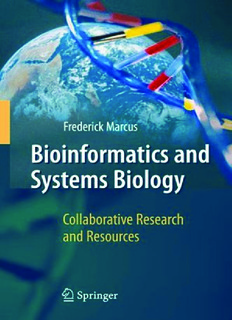Introduction
Purpose of This Book:
This textbook on collaborative research in bioinformatics and systems biology, which are key elements of modern biology and health research, highlights and provides access to many of the methods, environments, results and resources involved, including integral laboratory data generation and experimentation and clinical activities. Collaborative projects embody a research paradigm that connects many of the top scientists, institutions, their resources and research across Europe and the world, resulting in world-class contributions to bioinformatics and systems biology.
Central Themes: A number of themes are expressed and described, which guided the selection of material and its presentation:
• This book concentrates on collaborative research projects which have a significant computational biology component. A chapter with a title such as “Cancer” therefore covers the area in this restricted context. Moreover, most large-scale collaborative projects in Europe are funded by the European Commission. These projects often unify the best laboratories in Europe, which in turn are often themselves linked to worldwide programmed. Therefore, the research tends to accurately reflect the most up-to-date and best state-of-the-art research, which usually has a computational component.
• Computational approaches are a key part of much of modern life sciences research. This book aims at making researchers aware of the central importance of bioinformatics and systems biology in modern life sciences research and the wide range of publicly available resources generated by collaborative research programmed.
• A guide is needed for researchers to access the full range of resources available. Researchers are aware of laboratories, publications, databases and tools related to their areas, such as the European Bioinformatics Institute (EBI 2007) of the European Molecular Biology Laboratory (EMBL 2007), but in the form of individual pieces of a puzzle that they need for their work. They are not aware of how these resources are being linked together, nor what has been accomplished by doing so. This book shows how collaborative researchers are putting many of the pieces together in ways accessible to the entire biomedical community.
• Collaborative research approaches are highly productive and often essential. Extensive multilaboratory collaboration is necessary for assembling the scale of resources needed to advance in many areas depending on computational biology, especially when closely linked to experimentation. European collaborative research is highly successful owing to the autonomy and flexibility given to the researchers. Tools and resources have been assembled and developed which cover much of modern biology, ranging from gene definition and alternative splicing to protein sequence, structure, function and interaction networks, with direct application made to disease processes. Many similar projects are interlinked, leading both to broad resource development and to interrelated research programmed.
• Collaborative research results involving computational approaches represent the state of the art in many areas. This book aims to describe the most advanced research results and resources available, and to make them as accessible as possible in the form of a textbook and user manual. Often the best individual resources and results are mobilized for the best collective research.
• The research and resources described in this book are of worldwide interest and relevance. Even though the projects described are mostly funded by the European Commission with predominantly European participation, these projects are strongly interactive with worldwide resources. The resources involved include access to the databases EMBL-Bank for genome sequence, UniProt for protein sequence, Ensembl for genome browsing, MSD for protein structure, etc. Therefore, even though many tools originate from European projects, gateways are provided to worldwide research and resources.
• Science management is a key element of collaborative research. Many textbooks teach the underlying science, tools and procedures necessary to carry out research, but very few discuss how to plan and carry out research programmed, especially at the collaborative level. Each stage of a project, from planning to proposal to project organization to project operation, requires optimal organization and structures for optimal success. This book serves as a guide to understanding methods of modern collaborative research, and to assembling the level of resources needed for the complexity of much of modern life sciences research.
• The European Commission plays a key role in creating a collaborative research environment. Another motivation is to illustrate the role of the European Commission in health research. The Commission’s health research budget is smaller than the total of that of the member states of the European Union, but it is used strategically to beneficially link resources together, and is doubling under the new Seventh Framework Programme for Research (FP7 2007) compared with the Sixth Framework Programme (FP6 2007).









Be the first to review “Systems Biology”